AT OPENING OF TOME SCIENTIFIC BUILDING JUNE 24, 1885.
Tome Scientific Building, c.1958 - video (click on computer)
THE MAN BEHIND THE VISION
Charles Himes 1900
Photograph Courtesy of Dickinson College Archives
"WE STAND TODAY AT THE TRANSITION FROM THE OLD TO THE NEW. ---BEHIND US MORE THEN A CENTURY OF ACHIEVEMENT, BEFORE US THE GRANDER POSSIBILITIES OF THE UNLIMITED FUTURE; NOT SEPARATED FROM EACH OTHER BY THE IMAGINARY LINE OF A CLOSING CENTURY, BUT BY WHAT IS MORE SUBSTANTIAL AND EASILY RECOGNIZED, A BEAUTIFUL BUILDING WITH BROAD AND DEEP FOUNDATIONS."
In 1865, Dickinson College was beginning to build a modern curriculum with an emphasis in science. To help establish their new commitment to science, the college searched for new faculty members that would meet their high standards of education. A former student of Dickinson, Charles Francis Himes ( class of 1855), was recommended to the faculty and assured that, "Himes was fully alert to the educational thinking of the day, and particularly on the value of scientific training, its advantages over the obsolete classical course both for practical purposes and a mental discipline."1 For thirty-one years Himes dedicated his life to the service of Dickinson and worked hard to bring the College to the front of the modern trend. Himes had previously taught at Troy University and taken advanced study at the University of Giessen. His background of study in Germany was attractive to the faculty and students. German universities were known for their "emphasis on research" and "ideal of pure scholarship."2 Himes was also among one of the first to carry the honorary Ph.D. title that was becoming the "mark of the professional" at American Universities.3 His devotion to Dickinson led him to serve the college in many ways -- He was Secretary of the Faculty and of the Board of Trustees, and the Treasurer of the College for many years. Between 1888-1889 he was acting President of the College for nine months while there was a change in leadership. Himes was popular and successful in his teaching career and he was known to be hard working, persistent, and persuasive. Himes' devotion and love for science brought about many great changes for Dickinson.4
Himes dreamed of a new Science Building and worked hard to see his
vision realized. In 1878, he suggested the new building to the Scientific
Department and the following year he met with Spencer F. Baird, of the
Smithsonian Institution, and worked with him and Mongomery Cunningham Meigs,
a Smithsonian architect, on plans for the building.5 Soon
after, Himes published at his own expense his Sketch of Dickinson College.
This was the first attempt at a history of the college, and Himes hoped
it would help to forward the movement of the Science Building.6
In his "Sketch" Himes devoted chapter XV to "South College and Proposed
New Scientific Building"7
and in it presented his argument for the purpose of a New Science
Building.
At the time of Himes' Sketch of Dickinson College, the Science department was housed in South College along with the college library and museum. Himes felt that with the present accommodations the department could not continue to grow . A new building was "needed to properly house and care for, and satisfactorily use the additional appliances the College should have, and the institution is also losing, each day, opportunities for the collection of valuable educational material for want of a larger and more suitable building."8 Himes explained in his chapter that it would be to the great benefit of the College to construct a new building that would make more room for the library, museum, and science department. By doing so, resources would be made "more available for study, but would also form a gustier impression of the resources of the College in this particular, whilst the museum, with the encouragement of proper apartment, could easily be rendered as complete as might be rendered for the purpose of instruction."9 Himes proposed to the Trustees that such a building could be completed by the centennial of the college in 1883. The Trustees accepted Himes' proposal with great enthusiasm and authorized him to begin raising the money for the building, which was to cost no more then $25,000. It was noted that, "the building should be a building not for the sake of a building, but for the sake of its uses, and to meet the want of the College, as a college."10
The College allowed for a plot of land, ninety feet by two hundred and forty feet, to be used for the construction of the building. The location selected was adjacent to the northeast corner of Old West facing High Street. The spot was ideal because it had exposure to light from all sides, which was essential at the time. It was decided that the building would have to have ample provisions for:
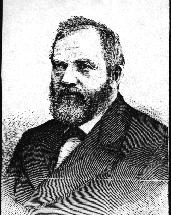
The trustees planned a financial drive to mark the centennial of
the College charter in 1881. As alumni and friends generously responded,
money was poured into Himes' building along with money for repairs and
modernization needed in other parts of the College.
Jacob
Tome, a trustee of the College, generously took on the cost of the
building which now bears his name. The
following is a list of $1,000 plus donators to the new scientific building.
| Jacob Tome | $25,000.00 |
| Rev. J.F. Goucher | $1,000.00 |
| Jackson and Wodin Mfg. Co. | $1,000.00 |
| Dr. J.W. Hendrix | $2,700.00 |
| Hon. John Patton | $3,000.00 |
| W.F. Sadler | $1,500.00 |
| W.J. Sibley | $1,000.00 |
| Gen. C.B. Frisk | $1,000.00 |
| J. Rives | $1,000.00 |
When the construction of Tome was finally underway, the plans were a much reduced version of the original plans Himes had envisioned. The Architect that the Board of Directors chose was Charles L. Carson. Bids were submitted to the College by several construction companies. A. J. Wetzel of Carlisle was selected with the lowest bid of $23,000. Wetzel got to work and the building materials he assembled for Tome traveled great distances to make their way to Dickinson. The stone for the steps and the large stone piece over the main door on the south side of the building lettered "Scientific Building" came from Ohio, for example. The granite for the rest of the building was brought to Carlisle from Port Deposit, Maryland.
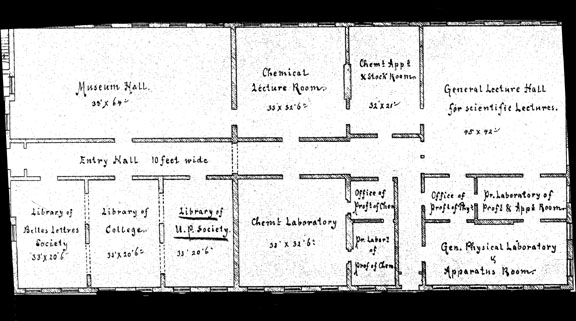
Original plans for Tome Scientific Building
Courtesy of Dickinson College
Archives
After its dedication, the Tome Scientific Building was much more than just the home for the Natural Sciences. The building featured all of the necessary equipment and space for Science, whileadequate space remained for many other features. The Tome Scientific Building housed all of the three libraries at Dickinson College: the College's own library, the library of the Belles Lettres Society, and the library of the Union Philosophical Society. It was also home to the College museum, along with the College archives and an observatory. Some of the most prized possessions housed in Tome were a collection of scientific apparatuses purchased in December of 1811 from Joseph Priestley. The three apparatuses acquired by Dickinson College were a Reflecting Telescope, Static electric machine, and Burning Glass.12
![]()
The ceremony of the removal of the Priestley burning
glass from Tome to Bosler, 1941 - video
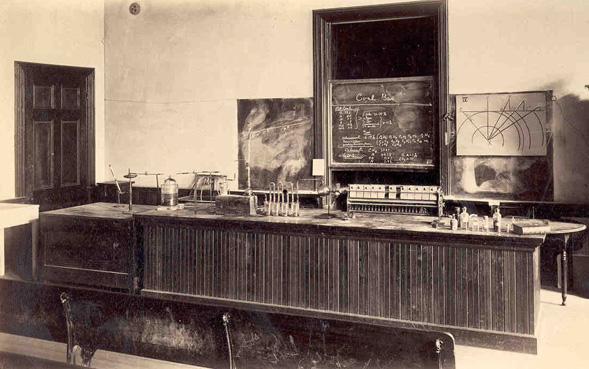
A Physics Lecture Room in Tome Scientific Building
showing up-to-date demonstration apparatus.
Photograph Courtesy of Dickinson
College Archives
In its early years, Tome was host to a pair of very interesting and groundbreaking experiments. On February 29, 1928, Raymond M. Bell, Class of '28, performed a demonstration of closed circuit television in Tome, before a significant crowd. He performed the demonstration with the assistance of Professor Fred Mohler of the Physics department.This was quite an impressive achievement at the time, as television was still in the very early stages of development. Television was not even available to the public until July of the same year.13
A few years later, in 1934, Tome witnessed a huge breakthrough in the use of quartz crystal for radio transmission. Custodian Grover Hunt was persuaded by a group of students to lend a hand cutting crystals. Hunt brought a rock saw that he had purchased while vacationing in Arizona, and while teaching the students how to cut with it, became familiar with the specifics of quartz electronics in return. Hunt soon produced a lapping machine that made the process of making crystals for radio much simpler, by a process of mechanization. Before this, the cutting and shaping of these crystals was "hit-or-miss." In a few years, Hunt went from custodian to millionaire.14
Over the years, Tome became the residence of the Chemistry Department, the Geology Department, and the Physics Department. The building had gradually fallen into a state of disrepair, and in 1947 all of the Chemical laboratories were enlarged at a cost of $35,000. This renovation and expansion necessitated the dispersal of the old museum, however.15
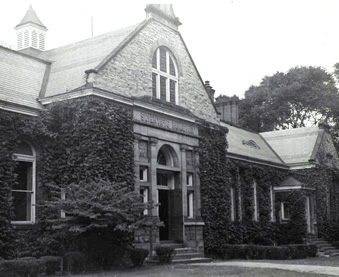
A more extensive and thorough renovation was still needed, however. The C. Scott Althouse Science Building was built in the mid-1950's, enabling the Chemistry Department to relocate, but for the most part, the Physics Department had been ignored. The Department was not ignored much longer. In January, 1958, the administration and the board of trustees of the College finally agreed to put up the money for the creation of a "real physics department", complete with a physical plant, apparatus, and personnel. The results were very good, better than many could have hoped. The renovation was completed quickly and, furthermore, Dr. Herber from the Biology Department decided that hisdepartment would remain in its current building, leaving Tome completely for Physics and Astronomy. The completely renovated Tome Scientific Building could now boast of the following:

For $165,000 dollars, and in only one and a half years, Tome Scientific Building went from a building of poor adequacy to an outstanding, state-of-the-art facility for Physics.16
![]()
Dedication ceremony, November 1958 -
video
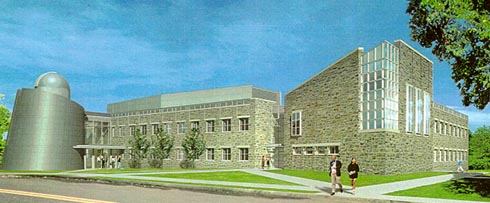
Tome has continued to serve a large portion of the science classroom needs of Dickinson College since its major renovations. Through the years it has undergone minor facelifts, ranging from the addition of office space, to dividing a room into four miniature laboratories. In the 1980's, however, the need for a modern scientific building was evident. The Physics Department helped push for a building where it could apply the hands-on-learning -for which it had a national ,reputation as pioneering - and have its students work with all possible technology. In May 1998, the department, much in the same manner of Hime's department over one hundred years before, rejoiced in the groundbreaking of a new building and a continuation of the old dream.
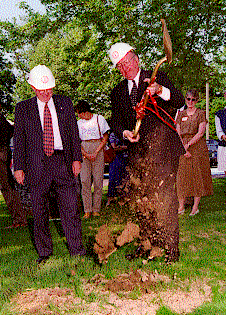
Dickinson College President
A. Lee Fritschler
Breaks Ground on the New Building
Photograph Courtesy of Dickinson
College Web Page
As this is written in the late spring of 1999, current plans are that the new Science Building will open in the fall of 1999. It is intended to house the mathematics, computer science, physics and astronomy departments. The newer, more spacious building will serve Dickinson's plan for "workshop" sciences, as opposed to the straight-forward lecture and occasional laboratory work that other colleges may offer.
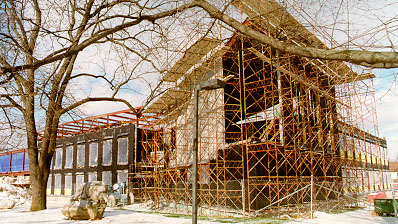
Construction Photograph of the
Dickinson College Science center (January 99)
Photograph Courtesy of Dickinson
College Web Page
While the Dickinson science community awaits this opening in 1999, Tome is left with the most serious dilemma of its lifetime. While it will remain in use to some degree, there has yet to be a final decision on how the building of which Charles Himes dreamed will continue to serve the College . Options reported thus far state that Tome may:
1.) Serve as the home for Environmental Science
2.) Become a Dickinson Museum
3.) Supplement the Current Science Buildings
4.) Serve as a Center for International Education
While all four options appear logical and useful, particularly returning Tome to its role of housing a Dickinson Museum, there will certainly be a void left as the major sciences leave Tome for the first time in over one hundred years. After all, Tome may lay claim at the moment to being the oldest continuously serving purpose built science building in United States education. One must, however, keep in mind the thoughts of the man most responsible for the existence of that very building in the first place, Charles Himes:
"WE STAND TODAY AT THE TRANSITION
FROM THE OLD TO THE NEW. ---BEHIND US MORE THEN A CENTURY OF ACHIEVEMENT,
BEFORE US THE GRANDER POSSIBILITIES OF THE UNLIMITED FUTURE; NOT SEPARATED
FROM EACH OTHER BY THE IMAGINARY LINE OF A
CLOSING CENTURY, BUT BY WHAT IS MORE SUBSTANTIAL AND EASILY
RECOGNIZED, A BEAUTIFUL BUILDING WITH BROAD AND DEEP FOUNDATIONS."
--CHARLES H. HIMES AT OPENING OF TOME SCIENTIFIC BUILDING JUNE 24, 1885
While Himes spoke these words nearly one hundred and fifteen years
ago, they could be applied today in the exact same fashion. Science
is a subject in constant motion and constant change. Himes would
not be left empty with the current events of Dickinson College, for Tome
was merely a step in his dream, not the dream itself. The building
has served its students well and will continue to do so into a new century.
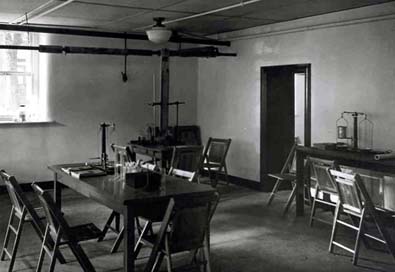
Photograph Courtesy of Dickinson
College Archives
Photograph Courtesy of Dickinson
College Archives
1) Charles Coleman Sellers, Dickinson College A History (Middletown, CT: Wesleyan University Press, 1973) 256.
2) Charles Coleman Sellers, Dickinson College A History (Middletown, CT: Wesleyan University Press, 1973) 10.
3) Sellers, 11.
4) Sellers, 256.
5) James Henry Morgan, Dickinson College 1783-1933 (Harrisburg, PA: Mount Pleasant Press, 1933) 348.
6) James Henry Morgan, Dickinson College 1783-1933 (Harrisburg, PA: Mount Pleasant Press, 1933) 348.
7) Charles Francis Himes, A Sketch of Dickinson College (Harrisburg, PA: Lanes Hart, 1879) 130.
8) Charles Francis Himes, A Sketch of Dickinson College (Harrisburg, PA: Lanes Hart, 1879) 131.
9) Charles Francis Himes, 131.
10) Charles Francis Himes, 132.
11) Charles Francis Himes, 132.
12) Scanned plans of Tome, Dickinson College Archives.
13) Raymond B. Bell, "Television Demonstration 1928," copy in Dickinson College Archives
14) Bruce Hathaway, Circuitry Wizards and New Agers Alike Can Get Good Vibes from Quartz (November 1988)
15) Charles Coleman Sellers, Dickinson College A History (Middletown, CT: Wesleyan University Press, 1973)
16) The Department of Physics and Astronomy, Dickinson College
Note on the music: Wagner's
Parsifal
was
composed in the same year as Tome's construction. Wagner died later
that same year. The selection comes from the opening sections of
the great work.